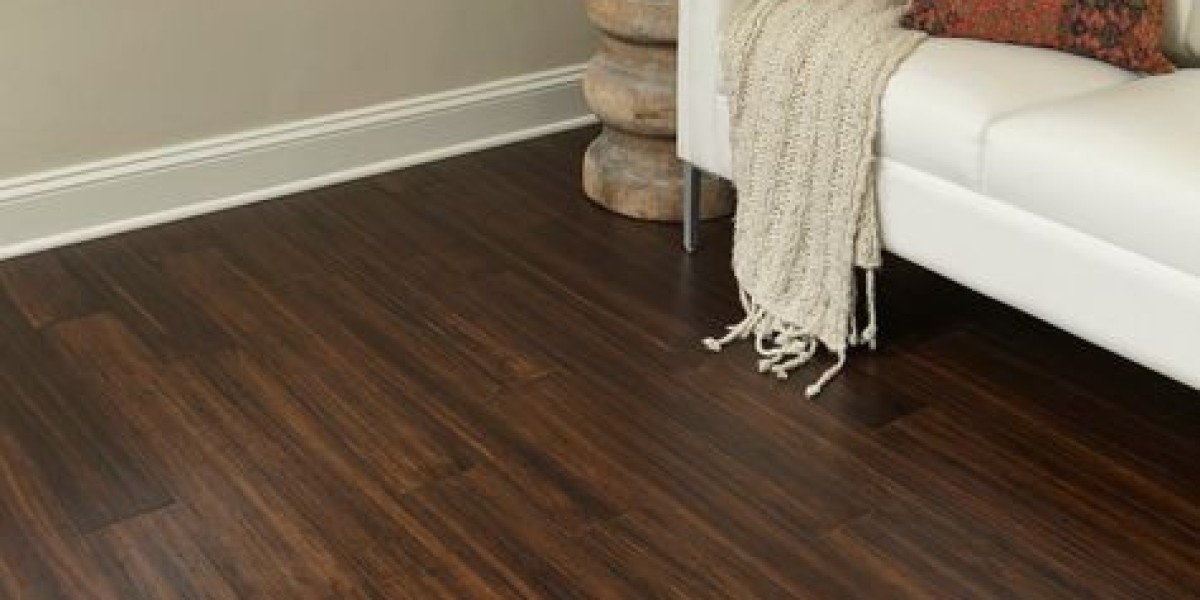As sturdy as an ancient oak yet as fresh as a spring bamboo shoot, bamboo flooring offers a unique blend of old-world resilience and new-age sustainability.
Bamboo flooring, a modern marvel of interior design, artfully combines aesthetic allure with environmental stewardship. Despite its relatively recent emergence in the flooring market, bamboo has carved a niche for itself, rapidly becoming the go-to option for eco-conscious homeowners and trend-savvy decorators. Its ascent can be primarily attributed to a suite of bamboo flooring benefits, which span from eco-friendliness to durability.
1. Sustainable Choice
Bamboo stands out in the world of flooring materials due to its remarkably swift growth rate. Unlike hardwood trees that can take decades to mature, bamboo can be harvested every three to five years, making it a shining example of sustainability. This rapid regeneration ensures a continuous supply without the ecological guilt associated with deforestation.
2. Durability and Strength
When it comes to durability, bamboo is no pushover. In fact, certain types of bamboo flooring surpass traditional hardwoods in hardness and longevity. Strand-woven bamboo, for instance, undergoes a manufacturing process that enhances its strength, making it suitable for high-traffic areas in homes and commercial spaces. This durability translates into a longer lifespan, reducing the need for frequent replacements.
3. Style and Versatility
Bamboo flooring is not just about eco-friendliness and durability; it also brings a chic and versatile aesthetic to the table. Available in a variety of hues and styles, it can complement a range of interior designs – from minimalist modern to rustic charm. Its natural texture imbues spaces with warmth and elegance, effortlessly bridging the gap between nature and indoor living.
4. Health and Air Quality
For those concerned about indoor air quality, bamboo flooring is a breath of fresh air. It is often low in volatile organic compounds (VOCs) and formaldehyde, especially when sourced from reputable manufacturers. This aspect is crucial for households with allergy sufferers or anyone prioritizing a healthy living environment.
5. Ease of Maintenance
In terms of maintenance, bamboo floors are relatively low-fuss. Regular sweeping or vacuuming to remove dirt and dust, combined with occasional mopping, is typically sufficient to keep these floors looking their best. The material's natural resilience against stains and spills also adds to its practicality, especially in bustling households.
6. Affordability
Despite its array of benefits, bamboo flooring often comes at a more budget-friendly price point than traditional hardwoods. This cost-effectiveness is another feather in its cap, offering homeowners the luxury of a premium-looking floor without the hefty price tag.
Empirical Evidence
Research and case studies underscore the practicality of bamboo flooring. For example, a study published in the "Journal of Sustainable Forestry" highlighted the reduced environmental impact of bamboo compared to other wood products. Similarly, market analyses reflect its growing popularity, with the global bamboo market expected to expand significantly, as reported by Grand View Research.
Real-World Applications
In real-world scenarios, bamboo flooring is increasingly seen in both residential and commercial spaces. Its adaptability has been showcased in everything from high-end luxury homes, where the emphasis is on aesthetics and sustainability, to busy retail spaces where foot traffic and durability are paramount.
Conclusion and Continuation
While bamboo flooring presents an array of advantages, it's crucial to consider the entire lifecycle and sourcing practices to maximize its eco-friendly potential. As we delve deeper into understanding bamboo flooring benefits, we must also explore the considerations for installation, the environmental impact of different types of bamboo flooring, and how it compares directly to other flooring materials.
Further Considerations in Bamboo Flooring
While the benefits of bamboo flooring are substantial, there are additional aspects to consider ensuring that this flooring choice aligns perfectly with specific needs and values.
7. Installation and Adaptability
Bamboo flooring comes in various forms, including planks that can be nailed down, clicked together, or even floated over an underlay, offering flexibility in installation. This adaptability makes it suitable for various substrates and locations, though it's essential to consider the climate. Bamboo, like wood, can expand or contract with changes in humidity. Therefore, understanding the local climate and choosing the appropriate installation method is critical to avoid warping or gapping.
8. Environmental Impact and Sourcing
Not all bamboo flooring is created equal, especially regarding its environmental footprint. The sustainability of bamboo flooring heavily depends on where and how the bamboo is grown, harvested, and processed. Choosing bamboo sourced from well-managed forests and processed using eco-friendlier practices (such as low-VOC adhesives and finishes) can enhance its green credentials.
9. Comparison with Other Flooring Materials
When weighed against other flooring options like traditional hardwoods, linoleum, or carpeting, bamboo holds its own in terms of durability, eco-friendliness, and maintenance. However, it's important to perform a side-by-side comparison considering factors like longevity, impact on indoor air quality, and recyclability at the end of its life cycle.
Market Insights and User Experiences
The global market for bamboo flooring continues to expand, driven not only by its aesthetic appeal but also by a growing awareness of its environmental benefits. User testimonials often highlight its durability and style flexibility, adding real-world credibility to claims of its longevity and versatility. Additionally, advancements in bamboo processing technologies are continually enhancing its quality and range of applications.
Looking Ahead: Innovations and Trends
The future of bamboo flooring looks promising, with technological innovations leading to even more robust and diverse products. Trends indicate a growing interest in unique colorations and textures, as well as a continued focus on sustainable and responsible sourcing. As research into bamboo's properties and uses deepens, we can anticipate advancements that further elevate its status in the flooring market.
Conclusion and Next Steps
In conclusion, bamboo flooring benefits extend far beyond its visual appeal, encompassing aspects of sustainability, health, and practicality. Its future appears increasingly bright as innovations and trends continue to underscore its potential. For those considering bamboo flooring, the next steps involve exploring specific products, examining samples in real-world settings, and consulting with professionals about installation and long-term care. By doing so, homeowners and designers can not only enjoy the immediate benefits of this remarkable material but also contribute to a more sustainable and aesthetically pleasing living environment.
Navigating Challenges and Embracing Future Possibilities
In embracing bamboo flooring, one must navigate a few challenges. While bamboo's hardness and durability are commendable, it's not impervious to all damage. High heels, pet claws, and sharp objects can still leave marks, and prolonged exposure to water can cause damage. Selecting high-quality bamboo flooring and adhering to proper care and maintenance can mitigate these concerns.
10. Regional Suitability and Climate Considerations
It's also crucial to consider the suitability of bamboo flooring in various climates. Regions with extreme changes in humidity might necessitate specific types of bamboo or particular installation methods. Consulting with flooring experts who understand these nuances can help in making an informed decision that ensures the longevity of the flooring.
11. Financial Investment and Long-Term Value
From an investment standpoint, bamboo flooring not only adds to the aesthetic appeal of a space but can also increase the property's value. Its durability and ease of maintenance make it a smart long-term choice for both residential and commercial properties.
Conclusion
Bamboo flooring stands at the intersection of sustainability, durability, and aesthetic versatility. Its rapid growth and renewal rate herald a new era in environmentally conscious living, while its strength and style cater to a modern, design-conscious audience. The benefits of bamboo flooring—ranging from its health and ecological advantages to its practicality in everyday use—make it a compelling choice for those seeking to blend ethical responsibility with contemporary living.
As the world leans more towards sustainable practices, bamboo flooring isn't just a trend; it's a reflection of a growing shift towards more mindful and environmentally responsible choices in every aspect of our lives. By selecting bamboo, consumers and designers are not just choosing a flooring material; they're making a statement about their values and vision for the future.
With its proven track record, growing market, and continuous innovations, bamboo flooring is more than just an aesthetic choice—it's a smart, sustainable decision that aligns with the aspirations of a new generation of homeowners and designers committed to making responsible, yet stylish living choices.
Thus, in contemplating bamboo flooring, one does not merely choose a floor but embraces a future where beauty, durability, and sustainability walk hand in hand.








